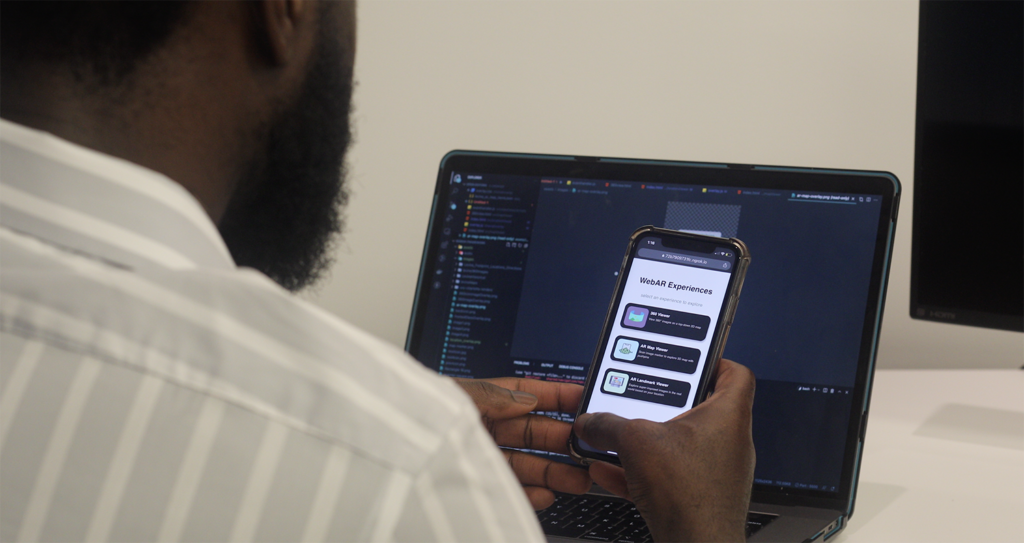Why the Time is Right for Web-Based AR

With the backing of big tech companies, such as Apple, Google, and Facebook, Augmented Reality (AR) is quickly gaining traction- but the ecosystem is still balkanized with platform-specific standards and apps. Web-based delivery of AR applications and experiences will be the key to standardizing applications across platforms and increasing accessibility for all users.
Due to heavy reliance upon sensory hardware (e.g. camera, LIDAR, microphone) and proprietary frameworks as well as performance considerations, AR applications have historically been distributed as compiled apps for a specific device or platform. While manageable under controlled user environments where hardware and software can be standardized, platform-specific compiled apps present a barrier for adoption in the consumer space and other Bring-Your-Own-Device (BYOD) scenarios where a diverse ecosystem of platforms are present, and challenges for content creators that must support these platforms.
The promise of web-based AR has been on the horizon for quite some time, but the possibilities have often fallen short of the promise for a number of reasons: poor browser support for still-emerging AR standards and sensory access, the relatively faster performance of compiled apps, and industry pioneers protecting proprietary AR ecosystems and frameworks. However steady progress has been made to address each of these reasons; browser support for the maturing WebXR Device API has greatly improved, faster mobile devices and WebAssembly have made computationally intensive operations such as image recognition within the web browser practical, and open source frameworks for AR functionality such as AR.js are becoming mature enough to serve as alternatives to commercial frameworks for basic AR applications.
We’re not entirely there yet. The development environment and toolset for web-based AR pales in comparison to building immersive apps with a commercial engine like Unity or Unreal, and Apple’s ARKit is still not easily accessible for web-based applications in need of SLAM tracking on iOS devices. We may also see renewed balkanization as the ecosystem moves from handheld AR (i.e. smart phones) to head-worn (i.e. smart glasses).
But the technology trend is clear – and the benefits immeasurable if the proliferation of Web 2.0 Progressive Web Applications (PWAs) is a precedent. Today, web developers can build new applications from existing web applications and integration sources, all upon a foundation of interpreted languages like JavaScript and open APIs. And while the smartphone era ushered a native app explosion, faster mobile devices, ubiquitous high speed internet, and improving browser standards allowed web applications to meet an increasing number of mobile app use cases. Ever faster connectivity standards such as 5G will drive similar trends with web-based AR, and allow private industry to thrive in a web-based AR ecosystem by providing real-time cloud-based AR services in spite of the significantly higher data and computation requirements involved with AR sensory data.
We’re still in for a bumpy ride on the road to web-based AR; the transition to head-worn AR devices in particular will likely breathe fresh life into platform-specific compiled apps for a season, as content creators wrestle with utilizing the native capabilities of smart glass devices running on increasingly lower energy profiles. In the meantime, the web-based AR ecosystem will mature and proliferate on smartphones and tablets and build better bridges into those head-worn native capabilities. For the first time, the web-based AR content creator has a mature smart phone user base today- and a brighter head-worn future tomorrow.

Don Shin is the founder and CEO of CrossComm- an award-winning mobile, web, and immersive app development studio with a 20+ year history of deploying innovative technologies to solve the toughest problems and challenges. Under Mr. Shin’s leadership, the Durham, NC-based company has been recognized as one of the leading mobile and AR/VR app developers in the region by clutch.co, and has been nationally recognized as the Minority Technology Firm of the Year (2015) by the US Dept. of Commerce. Mr. Shin has been a passionate advocate for human-centric user interfaces throughout his career, and is currently interested in exploring the future of XR/spatial computing and leveraging app innovation to advance social good.
The Featured Blog Posts series will highlight posts from partners and members of the All Things Open community leading up to the conference in October.
